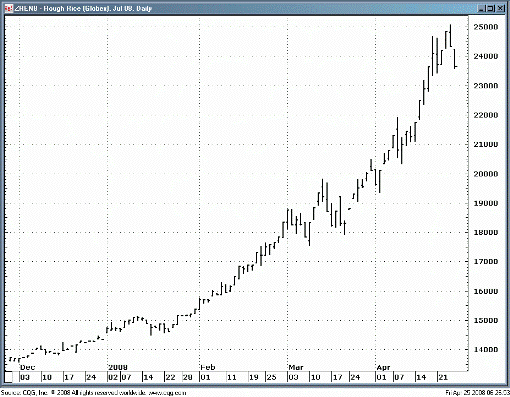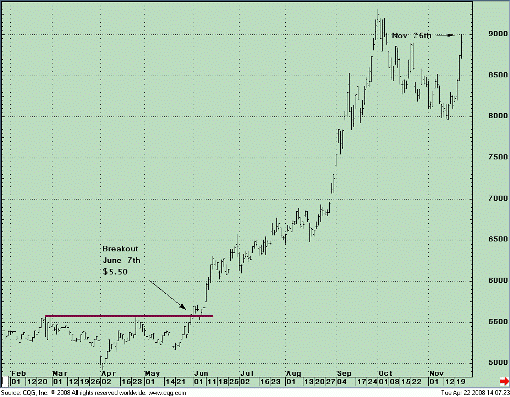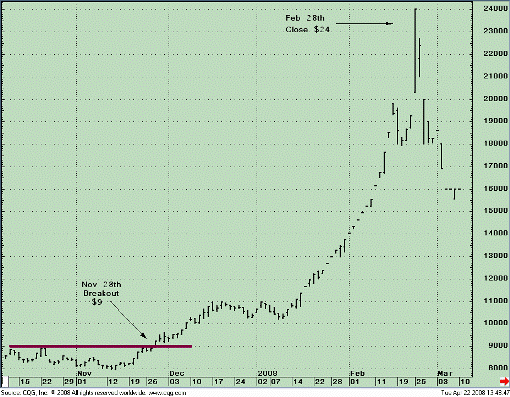Can You Profit From The Rice Shortage?
Commodities / Agricultural Commodities Apr 29, 2008 - 02:58 AM GMTBy: George_Kleinman
 How do we know when irrational exuberance has unduly escalated asset values?--Alan Greenspan, 1996
How do we know when irrational exuberance has unduly escalated asset values?--Alan Greenspan, 1996
Rice was in the limelight this past week. Costco and Sam's Club limited the amount of rice customers could buy because of the irrational exuberance of its rice customers. The rice chart below (this is a fairly thin market that's not too actively traded in the futures) looks like an accelerated rocket ride to the moon. Historically, these kinds of moves always seem to end poorly.
July Rice Futures

Source: Commodity.com
Viewing the rice chart evoked memories of another recent price movement that also exhibited parabolic (straight up) tendencies.
Today I'll share with you the remarkable story of a virtually impossible market move that theoretically returned 5,000 percent on margin in just three months. Even the sleaziest of investment scam artists wouldn't promise returns of this magnitude; after all, these numbers sound ridiculous.
But this theoretical--and seemingly impossible--move was a reality. What's even more remarkable is that this phenomenal 20,000 percent return annualized isn't even being measured from the theoretical bottom to top. Before it began, the market in question had already doubled in price. Plus, like rice, this move took place in a market that isn't generally known for big moves at the fairly low volume US futures exchange, the Minneapolis Grain Exchange (MGE).
This is the story of one of the most incredible price moves in the history of markets. I lived through this with two clients; one was on the right side of the move, and one wasn't. The client on the right side watched his account grow by seven figures, and the guy on the wrong side watched his account decrease by a similar amount.
This is a story of greed, stubbornness and vision. Looking back, the market signaled all that anyone needed to see--both fundamentally and technically--to be on the right side of it. It looked easy to profit. But, then again, it's never easy, and hindsight is always 20/20. By reviewing what happened here, we can learn how to effectively trade markets like this in the future.
This is the remarkable story of the Minneapolis wheat market of 2007-08.
There are three major varieties of wheat traded on US exchanges. The most plentiful variety is hard winter wheat, traded in Kansas City. This type of wheat is used for bread and grown in a number of states, primarily Kansas, Texas and Oklahoma.
The Chicago variety is soft winter wheat used for cakes and pastries, grown in areas such as Missouri and Illinois. The spring variety that's traded at the MGE is primarily grown in North Dakota but also South Dakota, Montana and Minnesota. Unlike the winter varieties, as its name implies, spring wheat is planted in the spring and harvested in late summer. It's a premium, higher-protein variety used in baked goods such as bagels, French bread and hard rolls.
In 2007, the world experienced wheat production problems because of devastating heat stress in Europe, Australia, Russia and the Black Sea region. The result: Wheat prices rose dramatically over the second half of the year.
In early June, the Minneapolis wheat futures formed a bottom as the market broke above $5.50 per bushel. The chart below shows the clear breakout and sharp rally up to $9. The move from $5.50 to $9 was dramatic in itself, the equivalent of a $17,500 move for just one 5,000 bushel contract.
Minneapolis Wheat 2007

Source: Commodity.com
High prices generally lead to increased production and lower prices. However, in the US, the winter wheat crop (planted that fall for a summer harvest) was poor, and the winter crop protein content was low. This put additional pressure on the spring wheat crop to replenish the supplies of high protein wheat.
But wheat farmers in North Dakota and Minnesota, lured by the biofuels promise of potentially higher corn and soybean prices, planted more of those crops while reducing their spring wheat acres. The growing weather that summer in the Dakotas was less than ideal, resulting in a short crop. This combination of events combined to create the lowest level of world wheat supplies in more than 60 years.
In 2007-08, the global supply of wheat as a percentage of usage was just 18 percent, the lowest number since World War II. This scenario created an even greater demand for the already short Minneapolis variety; in other words, it was a perfect market storm. Smaller supplies and greater demand resulted in not just a sharp gain in the Minneapolis futures prices, but Minneapolis spring wheat also gained dramatically in relation to the already high prices for the Chicago and Kansas City varieties.
Although millers can substitute different wheat varieties for many applications, spring wheat is required to blend higher protein bread types, and it's the variety most prized by the Japanese (who import most of their spring wheat from the US).
Prices continued rising into early 2008, reaching the all-time high of $11 per bushel in January. During February, the Japanese entered the marketplace with a tender looking for 80,000 tons of spring wheat. Even though prices were at all-time highs (with every economic incentive for farmers to clean out their bins), the Japanese only received offers for 50,000 tons.
This was a wake-up call to wheat traders who started believing the US was completely sold out of spring wheat with six full months until the next crop even became available. The result was a classic buying panic. Prices soared in a parabolic move higher, reaching a truly incredible price of $24 per bushel by the end of February.
March 2008 Minneapolis Wheat

Source: Commodity.com
It's tough to put these numbers in their proper perspective, but let's try.
Up until 2007, the all-time high price for Minneapolis wheat was $7.23 per bushel, touched briefly in May 1996. In that year, just a few months later when the new crop became available, the price was back below $4 per bushel. For seven years following, wheat prices weren't able to trade above the $4-per-bushel level. For the majority of those years, it was rare to see a $1-per-bushel move for an entire year. In contrast, the price of spring wheat moved more than $4 per bushel in just one week in February 2008.
In late 2007, the margin to trade one contract of spring wheat on the MGE was $1,350, an all-time high. As the market moved higher, the exchange eventually raised margins to $7,150 per contract.
What do these numbers mean in real dollars? A futures contract for Minneapolis wheat is a standard size: 5,000 bushels. Therefore, every penny-per-bushel movement in price is equivalent to a $50 profit or loss per contract traded.
Margin in futures is like a good faith deposit and is returned to the trader when he or she exits, plus any profits or minus any losses. So a limit move of 30 cents returns the equivalent of $1,500 per contract to the trader on the right side and removes this amount from the player on the wrong side. If the market moves more than this number, the additional margin money is added to the account of the winner and must be posted by the loser to his or her account.
At the beginning of this year, the March contract was trading at the all-time high price of $10 per bushel. This was up from $5 per bushel in early 2006. The market had already doubled, and one contract returned the equivalent of $25,000 on this $5 move. The move from $10 to $24 represents an additional $70,000 profit or loss for just one contract in just a few months. The $5 move Feb. 28 alone equaled $25,000 on just a single contract; that's $70,000 on a $1,350 margin deposit for one contract, equivalent to 5,185 percent in only three months.
Imagine being on the wrong side of this move, thinking prices were just too high. Anyone who thinks he or she has deep enough pockets to ride out any move should heed the words of the great economist John Maynard Keynes: “The market can stay irrational longer than you can stay solvent.”
In the real world, folks across the globe paid more for a premium loaf of bread or a Kaiser roll (both requiring high protein wheat). That brings up the question: Who benefits from a price move like this?
Other than the traders on the right side of the market, you can feel good for those farmers who held onto some of their production from the 2007 crop and sold in the upper double digits; these guys were big winners. However, there weren't many because the nature of a market like this is that the great majority of farmers sold out their wheat inventories months before. Why not take that $10 per bushel in January, the highest price ever seen in history to that date? That's why there was a dearth of spring wheat in the first quarter of 2007.
This price move in Minneapolis wheat was unprecedented and wouldn't happen in the days of a smaller population, fewer hedge funds and pit-traded (versus electronic) markets. To cope with the volatility, the MGE put into place a new limit policy. Price limits for nearly 100 years were restricted to 20 cents per bushel per day. Today limits can expand from 30 cents to 60 cents, then to 90 cents and all the way up to $1.35 based on a formula contingent on how the market traded the day before. In the spot month, prices can move anywhere.
At the price peak, grain merchandisers were scouring five states in search of spring wheat. But there was none to be found. The price for a bushel of spring wheat would match demand. However, the day the world supposedly ran out of spring wheat was actually the day the highs were reached. In 1928, the great trader W.D. Gann made the following observation:
The history of the world shows that there never has been a time when there was a great demand for anything, whether it be a product of the mine, factory or farm, that sooner or later a supply in excess of that demand did not develop. This is but a natural law.
The March contract that traded as high as $24 per bushel expired at $17. Today prices are closer to $11 per bushel, even though not one additional bushel of spring wheat has grown since last year. In fact, farmers are just now planting this year's spring wheat crop. In the end, it wasn't a question of supplies increasing. Rather, we now know demand was totally satiated.
Some bakers switched to lower protein wheat. Some consumers balked at paying $1 for one bagel, but the real reason prices came off was because the Japanese and others paid up until their demand was satiated. These buyers were afraid they would run out, so they went on a panic-buying streak and effectively bought their entire needs for the year in February. This action created the parabola and the high price.
Some millers are still working through $20 wheat today. When the panic buying dried up, the move back down began.
There are three major lessons a trader can learn from this.
1. Never fight the adage “the trend is your friend.” This is especially true during major uptrends. Who could have forecast oil at $119 per barrel a few months ago? Top picking this one has been expensive for the short seller.
2. It's not the news but how the market reacts to the news that's important. Certainly it's the news that sets the public perception, but you must be alert for divergences between the news and market action. It all has to do with expectation versus reality.
Look for the divergence between what's happening and what people think is supposed to happen. When the big turn comes, the general public will always be looking the wrong way. There are certain ways to analyze reactions to news (or even a lack of news).
- Moves of importance invariably tend to begin before there's any news to justify the initial price move. Once the move is underway, the emerging fundamentals will slowly come to light. A big rally (decline) on no news is almost always very bullish (bearish).
- It's generally not good practice to buy after a lot of very bullish news or sell after an extremely bearish report because both good and bad news are often already discounted in price.
However, in extreme markets, men and women of reason lose all sense of proportion. They start to believe the propaganda that the world has literally run out of this or that, but it never happens. In the late 1970s, the Hunt Brothers ran silver from $5 an ounce to more than $50. They felt it would go up forever but forgot at some price Grandma's silver candlesticks come out of the cupboard and drop into the smelter.
The richest men in the world (at that time) lost all sense of reason and proportion--and $2 billion in the process. Rice traders: Take heed, and remember what Gann told us. “The history of the world has shown that there has never been a time when there was a great demand for anything that a supply in excess of demand didn't develop.”
Good trading, and good luck.
By George Kleinman
President
Commodity Resource Corp.
Lake Tahoe,
Nevada 89452-8700
http://www.commodity.com
George Kleinman is the President of the successful futures advisory and trading firm Commodity Resource Corp. (CRC). George founded CRC in 1983 while on the "floor" of the Minneapolis Grain Exchange to offer a more personalized level of service to traders. George has been an Exchange member for over 25 years. George entered the business with Merrill Lynch Commodities (1978 - 1983). At Merrill he attained the honor of 'Golden Circle' one of Merrill's top ten commodity brokers internationally. He is a graduate of The Ohio State University with an MBA from Hofstra University. George has developed his own proprietary trading techniques and is the author of three books on commodity futures trading published by the Financial Times.
He is Executive Editor of Futures Market Forecaster, a KCI Financial publication. In 1995, George relocated CRC to Nevada and today trades from an office overlooking beautiful Lake Tahoe. The firm assists individuals and corporate clients. CRC¹s exclusive clearing firm is R.J. O'Brien with all client funds held at RJO (assets in excess of $1.9 billion). Founded in 1914, R.J. O'Brien is a privately owned Futures Commission Merchant, and one of the most respected independent futures brokerage firms in the industry. RJO is a founding member of the Chicago Mercantile Exchange, a full clearing member of the Chicago Board of Trade, New York Mercantile Exchange, Commodity Exchange of New York and the New York Board of Trade. RJO offers the latest in order entry technology coupled with 24-hour execution and clearing on every major futures exchange worldwide. There is risk of loss when trading commodity futures and this asset class is not appropriate for all investors.
Risk Disclaimer
Futures and futures options can entail a high degree of risk and are not appropriate for all investors. Commodities Trends is strictly the opinion of its writer. Use it as a valuable tool, not the "Holy Grail." Any actions taken by readers are for their own account and risk. Information is obtained from sources believed reliable, but is in no way guaranteed. The author may have positions in the markets mentioned including at times positions contrary to the advice quoted herein. Opinions, market data and recommendations are subject to change at any time. Past Results Are Not Necessarily Indicative of Future Results.
Hypothetical Performance
Hypothetical performance results have many inherent limitations, some of which are described below. No representation is being made that any account will or is likely to achieve profits or losses similar to those shown. In fact, there are frequently sharp differences between hypothetical performance results and the actual results subsequently achieved by any particular trading program. One of the limitations of hypothetical performance results is that they are generally prepared with the benefit of hindsight. In addition, hypothetical trading does not involve financial risk, and no hypothetical trading record can completely account for the impact of financial risk in actual trading. For example, the ability to withstand losses or to adhere to a particular trading program in spite of trading losses are material points which can also adversely affect actual trading results. There are numerous other factors related to the markets in general or to the implementation of any specific trading program which cannot be fully accounted for in the preparation of hypothetical performance results and all of which can adversely affect actual trading results.
George Kleinman Archive |
© 2005-2022 http://www.MarketOracle.co.uk - The Market Oracle is a FREE Daily Financial Markets Analysis & Forecasting online publication.



